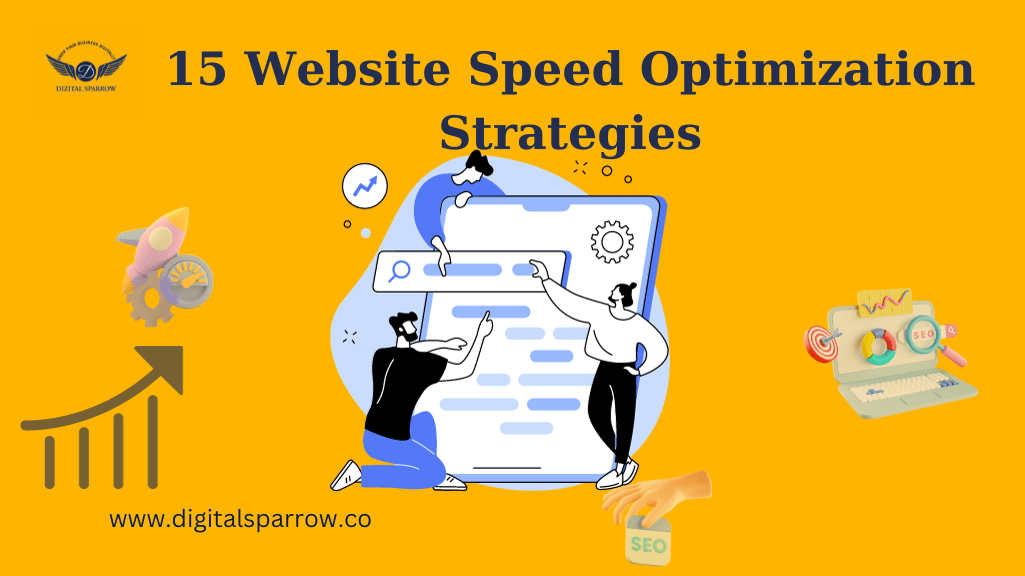In the fast-paced digital era, where every second counts, website speed is the silent powerhouse that can make or break your online presence. Slow-loading websites not only frustrate users but also impact search engine rankings. In this comprehensive guide, we will delve into 15 cutting-edge strategies to optimize your website speed and ensure a seamless user experience.
1. The Need for Speed: Understanding the Impact
- User Satisfaction: For a great user experience, website performance is critical. Slow-loading websites irritate visitors, leading to higher bounce rates and worse user satisfaction.
- Conversion Rates: A faster website leads to increased conversion rates. Users are more likely to engage and convert when they can navigate without interruptions.
- SEO Performance: Search engines priorities websites that load quickly in their rankings. Speed optimization is more than simply a user-friendly technique; it has a direct impact on your visibility and ranking in search engine results pages.
- Mobile Responsiveness: With an increase in mobile consumers, website performance is critical for mobile optimization. Fast-loading pages are critical for offering a consistent experience across multiple devices.
- Competitive Edge: In a competitive digital landscape, a faster website can give you a significant edge. Users are more likely to choose a website that loads quickly over a sluggish competitor.
- Reduced Bounce Rates: Users are less likely to abandon a site that loads quickly. Reduced bounce rates contribute to a higher retention rate and increased engagement.
- Perceived Credibility: A fast website is often associated with professionalism and reliability. Users may perceive a slow site as outdated or less trustworthy.
2. Diagnose and Benchmark with Tools
- Google Page Speed Insights: Initiate your website speed optimization journey by using this tool to assess your site’s performance. Gain valuable insights into loading times, potential optimizations, and user experience.
- GT Metrix: Benchmark your website against various metrics using GT Metrix. This tool provides a detailed analysis, including page speed scores, optimization recommendations, and a waterfall breakdown of your site’s components.
- Pingdom: Use Pingdom to test the speed and performance of your website. It has an easy-to-use interface that highlights performance grades, load times, and ideas for improvement.
- Lighthouse: Lighthouse, which is integrated with Chrome Dev Tools, delivers an in-depth audit of your web page, encompassing performance, accessibility, SEO, and other factors. Lighthouse can help you identify particular areas for improvement.
- Web Page Test: Web Page Test provides a comprehensive assessment of your website’s speed. This tool analyses performance from multiple places and gives a comprehensive performance review.
3. Optimize Images Without Sacrificing Quality
- Image Compression: Use efficient compression techniques to reduce file sizes without sacrificing image quality. JPEG optim and Image Optim, for example, can automatically compress photos for best online performance.
- Choose Appropriate Formats: Choose the appropriate image format based on the content. JPEG is good for pictures, but PNG is appropriate for images with transparency. WebP, a current format, combines quality with reduced file sizes.
- Lazy Loading: Use lazy loading to load images only when they enter the user’s viewport. This reduces initial page load times, which is especially important for content-heavy pages with a lot of graphics.
- Responsive Images: Use responsive design concepts to display suitably scaled images dependent on the user’s device, avoiding wasteful data transfer and optimizing load times on mobile devices.
4. Leverage Browser Caching
- Set Expires Headers: Configure your server to include expires headers for static resources, specifying a future date when the browser should request updated files. This minimizes the need for repeated downloads and enhances caching efficiency.
- Cache-Control Directives: You can create caching rules using Cache-Control directives. Maximum cache age is determined by parameters such as max-age, and s-maxage can define a distinct number for shared caches.
- Apply ETags: ETags aid in the validation of cached components, ensuring that the browser only accesses resources that are up to date. ETags that are correctly configured reduce server load and improve cache efficacy.
- Take advantage of Content Delivery Networks (CDNs): Distribute static resources among CDNs to allow users to receive cached material from servers that are geographically closer to them, lowering latency and speeding up page loading.
5. Minify CSS, JavaScript, and HTML
- Remove Unnecessary Characters: Minification involves eliminating unnecessary characters like white spaces, line breaks, and comments from CSS, JavaScript, and HTML files, reducing their size.
- Concatenate Files: Combine multiple CSS or JavaScript files into a single file to minimize the number of HTTP requests, streamlining the loading process for improved performance.
- Utilize Minification Tools: Employ minification tools such as UglifyJS for JavaScript and CSS Nano for CSS. These tools automatically optimize code, ensuring it remains readable to developers while being highly efficient for browsers.
- HTML Minification: Minify HTML by removing spaces, comments, and unnecessary elements, decreasing page load times and improving overall website speed.
6. Enable Compression
- Gzip Compression: Use Gzip, a widely used compression technology, to minimise the amount of CSS, JavaScript, and HTML files during transmission, resulting in faster page loading.
- Brotli Compression: Consider utilizing Brotli, a modern compression method recognised for delivering greater compression ratios than Gzip. Brotli is particularly good in reducing file sizes for text-based resources.
- Configure the Server for Compression: Check that your server is configured to allow compression. Depending on the server software used, this entails configuring compression modules or configurations.
- Content-Encoding Header: Include the Content-Encoding header in your server responses to indicate the compression method used. This guarantees that browsers understand how to decompress and render compressed material.
7. Prioritize Critical Rendering Path
- Optimize CSS Delivery: Prioritize the loading of critical CSS styles that are essential for rendering above-the-fold content. This ensures that users quickly see the most important parts of your webpage.
- Async Loading of JavaScript: Implement asynchronous loading for non-essential JavaScript resources. By allowing these scripts to load independently, you prevent them from blocking the rendering of crucial page elements.
- Defer Non-Critical JavaScript: Defer the loading of non-essential JavaScript until after the initial rendering. This way, essential content is displayed promptly, and secondary scripts load in the background.
- Minimize HTTP Requests: Reduce the number of HTTP requests by combining and minifying CSS and JavaScript files, streamlining the critical rendering path for faster page loading.
8. Utilize Content Delivery Networks (CDNs)
- Global Content Distribution: Use CDNs to distribute static content over a network of servers strategically situated throughout the world. This guarantees that customers receive data from servers that are geographically near to them, minimizing latency and speeding up content delivery.
- Caching for Faster Retrieval: CDNs cache static resources like as images, stylesheets, and scripts, allowing for speedier retrieval when users return to your site. This decreases the load on your origin server and increases website performance overall.
- Load Balancing: CDNs frequently use load balancing techniques to distribute user requests across multiple servers. This reduces server overburden during traffic spikes, guaranteeing consistent website speed and stability.
- Security Enhancements: CDNs frequently include security elements that guard against DDoS assaults and unauthorized access. This improves the overall security posture of your website.
9. Implement Asynchronous Loading for JavaScript
- Non-Blocking Script Execution: Loading JavaScript asynchronously allows the browser to keep rendering the page while fetching and executing scripts. This avoids scripts from impeding other vital resources, resulting in faster page load times overall.
- Async Attribute: In script tags, use the “async” attribute to direct the browser to fetch the script asynchronously. This is especially beneficial for non-essential scripts that have no effect on the page’s initial rendering.
- Defer Loading for Non-Critical Scripts: Consider utilizing the “defer” attribute for non-critical scripts. This prevents script execution from beginning until the HTML parsing is complete, guaranteeing a seamless and uninterrupted user experience.
- Dynamic Script Loading: Load JavaScript dynamically for certain interactions or features, retrieving scripts only when needed. This reduces the initial payload, resulting in faster page loading.
10. Evaluate and Upgrade Hosting Plans
- Traffic Analysis: Regularly assess your website traffic to ensure your hosting plan aligns with current and anticipated demands. Analyze peak traffic times and assess server performance during these periods.
- Server Resources: Upgrade to a hosting plan that offers sufficient CPU, RAM, and storage resources. Inadequate resources can lead to slow loading times and decreased overall website performance.
- Content Delivery Optimization: Choose hosting plans that support content delivery optimization, including CDNs. This ensures global users experience fast loading times by accessing content from servers geographically closer to them.
- Scalability Options: opt for hosting providers that offer scalable solutions. This allows you to easily upgrade your resources as your website grows, accommodating increased traffic without compromising performance.
- Assess Necessity: Evaluate the necessity of each third-party script on your website. Consider whether the benefits outweigh the potential impact on loading times.
- Load Asynchronously: Configure third-party scripts to load asynchronously to prevent them from blocking the rendering of the entire page. This ensures a smoother user experience, particularly during initial loading.
- Strategic Placement: Place third-party scripts strategically in your code to minimize their impact on critical rendering paths. Load them at the end of the page or use deferred loading for non-essential scripts.
- Consolidate and Minify: Combine multiple third-party scripts into a single file and minify the code to reduce the number of HTTP requests and enhance overall website performance.
11. Reduce Server Response Time
- Optimize Database Queries: Efficient database queries are crucial for quick server responses. Review and optimize queries to reduce the time it takes to retrieve and deliver data.
- Caching Mechanisms: Use server-side caching mechanisms to store frequently accessed data. This lowers the need for repetitive processing and speeds up response times.
- Reduce the number of HTTP requests: Reduce the amount of HTTP requests by unifying and minifying CSS and JavaScript files. This simplifies server connectivity and reduces overall response times.
- Upgrade Hosting Infrastructure: Consider upgrading your hosting plan or relocating to a more capable server to provide adequate resources for servicing incoming requests quickly.
- Reducing server response time is critical for a fast-loading website, since it improves user experience and search engine rankings. Optimizing queries, using caching, and upgrading infrastructure all help to achieve fast and efficient server answers.
12. Mobile Optimization: A Must
- Responsive Design: Implement responsive design principles to ensure your website adapts seamlessly to various screen sizes, providing an optimal viewing experience on mobile devices.
- Optimize Images for Mobile: Compress and resize images specifically for mobile users to reduce data transfer and enhance loading speed on smaller screens.
- Mobile-Friendly Navigation: Make it easier for mobile users to navigate by using clear, touch-friendly menus and buttons. A great mobile user experience is enhanced by intuitive navigation.
- Accelerated Mobile Pages (AMP): Consider using AMP to build lightweight, fast-loading mobile versions of your web pages. AMP improves mobile performance and is well-liked by search engines.
Customer pain points: https://startupadvice.in/from-problem-to-solution-uncovering-customer-pain-points/
13. Monitor and Continuously Optimize
- Performance Metrics Monitoring: Regularly track key performance metrics using tools like Google Analytics, Page Speed Insights, or GT metrix. This provides insights into loading times, user interactions, and potential bottlenecks.
- Regular Performance Audits: Conduct frequent performance audits to identify areas for improvement. Analyze user behavior’s and remain up to date on industry best practice’s.
- Keep up with Industry Trends: Keep up with changing technology and industry trends related to website speed optimization. Implement new strategies and technology as they arise to stay ahead in the competitive digital landscape.
- A/B Testing for Optimization: Use A/B testing to experiment with alternative optimizations and evaluate their influence on user engagement and conversion rates. Utilize data-driven insights to continuously improve the performance of your website.
14. Optimize Third-Party Scripts
Assess Necessity: Evaluate the necessity of each third-party script on your website. Consider whether the benefits outweigh the potential impact on loading times.
Load Asynchronously: Configure third-party scripts to load asynchronously to prevent them from blocking the rendering of the entire page. This ensures a smoother user experience, particularly during initial loading.
Strategic Placement: Place third-party scripts strategically in your code to minimize their impact on critical rendering paths. Load them at the end of the page or use deferred loading for non-essential scripts.
Consolidate and Minify: Combine multiple third-party scripts into a single file and minify the code to reduce the number of HTTP requests and enhance overall website performance.
15. Conduct A/B Testing for Continuous Improvement
- Identify Variables: Initiate A/B testing by identifying specific variables to test, such as different website layouts, calls-to-action, or page load optimizations.
- Define Metrics: Make it clear the metrics you want to increase, whether it’s conversion rates, bounce rates, or average session time. Setting quantifiable goals is critical for assessing the efficacy of improvements.
- Randomized Testing: To achieve unbiased findings, test modifications on a small, randomly selected portion of your audience. You may then compare the performance of the original and changed versions.
- Iterative Optimization: Iteratively improve your website based on the outcomes of A/B tests. Implement successful adjustments and continue testing to identify further areas for improvement.

Trends of paid search: https://digitalsparrow.co/trends-in-paid-search/
Conclusion: Speeding Toward Success
In a digital landscape where user attention spans are fleeting, a lightning-fast website is your secret weapon. By implementing these 15 website speed optimization strategies, you’re not just enhancing performance; you’re ensuring that every user interaction is smooth, seamless, and positively impactful. Embrace the need for speed, and watch your website accelerate toward success.


Can you be more specific about the content of your article? After reading it, I still have some doubts. Hope you can help me.
Thanks for sharing. I read many of your blog posts, cool, your blog is very good.
Thanks for sharing. I read many of your blog posts, cool, your blog is very good.
Your article helped me a lot, is there any more related content? Thanks!